| |
| |
Photographer,
Location |
Images |
Comments |
|
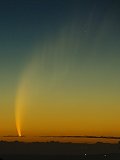
|
Kevin
Crause,
Mossel Bay, Western Cape, South Africa
Jan. 17, 2007 |
#1,
#2 |
An
incredible naked-eye object last night (17-01-07). First
night the comet was visible here due to cloud cover.
Photo
details: Nikon
D2X, 120mm
lens, f/5.3, 9sec, ISO 200 |
|
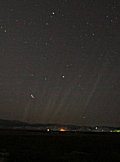
|
Daniel
Laszlo,
North of Wellington Colorado USA
Jan. 17, 2007 |
#1,
more |
NOTE:
While the comet is in the southern hemisphere, the comet's
tail is so long it can be seen half a world away--in the
northern hemisphere. This report comes from Colorado:
Paul
Robinson reported spotting the tail on Jan 16 west of
Boulder CO. As he described, the multiple streamers looked
like faint auroral rays. 10 degrees was the maximum length
I saw for the brightest streamer in 10x40
binoculars. Brightest star in the image is Enif, and
Delphinus is near the lower right.
Photo
details: Canon
20D, ISO 1600, f/4, 17mm lens, 20 seconds. Taken at
0038 UT on Jan 18 2007, 1838 MST on Jan 17.
The
tail was visible in binoculars about when Venus set. Suggestion:
Find the darkest western sky you can, and look at latest
by an hour after sunset. A site with zodiacal light visible
would be best. Cheers, Dan Laszlo, Northern Colorado Astronomical
Society. |
|
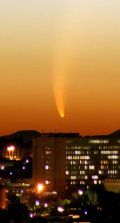
|
Hannes
Pieterse,
Bloemfontein, South Africa.
Jan. 16, 2007 |
#1,
#2 |
Photo
1 Canon
30D & 75 - 300mm f5.6 Lens settting 300mm F8; Exposure:
2 sec 800 ISO; Tripod and shutter release A lot of dust
in the atmosphere on the horizon Photo time: from 20:00
local time up 20:10
Photo 2 Canon 30D & 75
- 300mm lens, f/5.6, Lens settting: 205mm F8; Exposure:
1 sec 800 ISO; Tripod and shutter release A lot of dust
in the atmosphere on the horizon Photo time: from 20:00
local time up 20:10 |
|
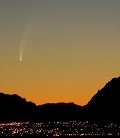
|
Guillermo
Abramson,
Bariloche, Argentina
Jan. 16, 2007 |
#1,
more |
Comet
McNaught is seen setting behind the Andes and the city of
Bariloche. The magnificent skyline of Cerro Catedral adds
its own beauty to the scene. |
|
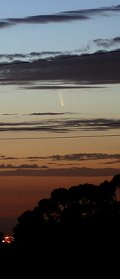
|
Kearn
Jones,
Adelaide, Australia
Jan. 17, 2007 |
#1,
#2 |
With
these pics I have tried to approximate the wonderful natural
vista that we had with the naked eye. Bush fire and summer
hazes affected the view, as it did over much of southern
Australia in recent times. Venus
in the second shot makes a nice comparison as well.
Photo
details: Canon
350D, 50mm
lens, f/1.4. |
|
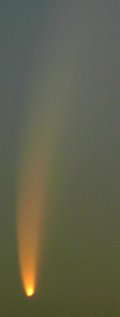
|
Trevor
Heath,
Levin, New Zealand.
Jan. 18, 2007 |
#1 |
Comet
became visible at 9.10pm with longer tail gradually appearing
as time progressed.
Photo
details: Canon
300D, 70-200mm
Sigma EX lens + 2 x Sigma APO convertor. 100 ASA, 5s
exposure @ f5.6 +2 compensation. |
|
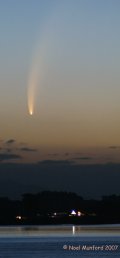
|
Noel
Munford,
Levin, New Zealand overlooking Lake Horowhenua
Jan. 17, 2007 |
#1 |
Photo
details: Fuji
S3, 70-200 zoom lens, Meade 1000mm f/10, 800 ISO, 2
sec. |
|

|
Felipe
Mac Auliffe,
San Pedro de Atacama, Chile
Jan. 17, 2007 |
#1,
|
Photo
details: Sony
CyberShot DSC-P200 |
|

|
Claudio
Basualto Merino,
Isla Tenglo, Puerto Montt, Chile
Jan. 16, 2007 |
#1 |
Photo
details: Nikon
D50, ISO 400, Shutter 4.5, F1/8 |
|
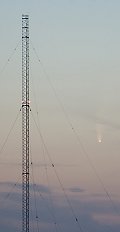
|
Keir
Davis,
Homebush bay, Sydney, Australia
Jan. 16, 2007 |
#1 |
I
never imagined I'd see a comet so bright in my lifetime!
Fantastic!
Photo
details: Canon
EOS 30D, 75-300mm
zoom lens at f/5.6, 1.3 sec. |
|
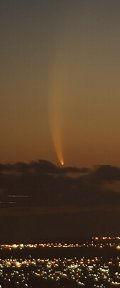
|
Ben
and Vic Levis,
Lesmurdie, Western Australia
Jan. 17, 2007 |
#1,
#2, #3 |
The
comet was a stunning sight from the top of the Darling Range,
Lesmurdie, overlooking the south of Perth City
Photo
details: Canon
EOS 1Ds MKII, 400mm f2.8L, 135mm f2L both with 2x tele-converter.
Exposure range 1/30 to 3 seconds. |
|
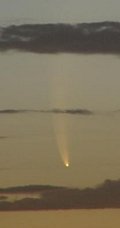
|
Trevor
Rowland,
Hallett Cove Beach, South Australia
Jan. 17, 2007 |
#1 |
Photo
details: Panasonic
FZ10, 100 ASA, 2.5 sec at F2.8 exposure. |
more
images: from Phil
Guerney of Mt Keith, Western Australia, Australia; from
Darryl Browning of Kalamunda, Western Australia; from
Chris Gordon of New Plymouth, New Zealand; from
Ross Wharton-Street at the War Memorial, in Fremantle, Western
Australia; from Milton Maritz
of Somerset West, South Africa; from
Leon van der Walt of Capetown, South Africa; from
Bryan Fleming of Narrogin Western Australia; from
George Ionas of Foxton Beach, North Island, New Zealand; from
Michael Warner of La Serena, Chile; from
Chris Parker of Perth, Western Australia; from
Juan Carlos Juele of Jose Ignacio, Maldonado, Uruguay; from
Trevor Rowland of Hallett Cove Beach, South Australia; from
Minoru Yoneto of Queenstown, New Zealand; from
Luis Pimentel of Puente Alto, Santiago, Chile; from
Roberto Riela of Montevideo - Uruguay;
|
|